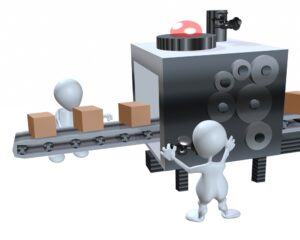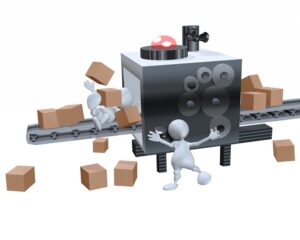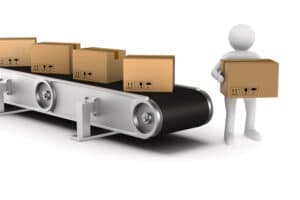According to the Theory of Constraints profit is always limited by a single resource. Similar in concept to a chain only being as strong as its weakest link, a job can only move through a shop at a rate governed by the slowest step in the process. This chokepoint is the “bottleneck”. Profit is directly linked to amount of work processes (i.e., your throughput).
Over the past few months we’ve looked into jobs, the hours employees work on them (or other things) – and getting as many productive (billable) hours as possible. We’ve talked about determining the most profitable job types and matching them to your most profitable customers. So, at this point we arrive at throughput.
Are you processing as many profitable jobs through your shop as possible?
The answer is “no” (hint: It’s always going to be no). It’s “no” because there is always a bottleneck – something that prevents you from processing more work and earning more profit. The key then is to identify the resource that is causing your current bottleneck and alleviate it.

In the previous article Unwind Your Jobs we encouraged readers to select an incoming job and document its progress through each stage in the work process. Two of the items to note were:
- How long did it stay in each stage?
- How much time lapsed between each stage when no work was being done (no value being added)?
If you worked through that exercise you already have a good idea where your potential bottleneck points are. Assuming you’re starting from scratch, carefully consider each step in the job process as you walk around your shop and observer.
In a perfect world this is a pretty simple process. Imagine your workflow in one linear progression of processes from Receiving to Customer Acceptance. A customer drops a job off at one end of the building where you receive it, work progresses down a line to the other end of the building where your customer accepts the finished (repaired) product. For an electric motor repair, your workflow line might look something like this with the following stations:
Receiving > Inspection > Test > Document > Disassembly > Strip and Burn Windings > Install New Coils > Test > Prep and Clean Parts > Assemble > Test > Run > Delivery

Now picture a conveyor belt that moves the job from the Receiving end to the Delivery end. In a perfect world each station would take exactly the same amount of time to accomplish its work on every job. Jobs would enter the process at a steady rate, and as each job entered the Receiving end, another would be exiting at the Delivery end. Nothing slows the effort – no bottlenecks.
In a slightly more realistic version of this, you walk down the line and notice that new jobs come in and enter the workflow at random. As the jobs get processed queues form at some of the stations while other stations sit empty waiting for work. The stations with queues show you where work is backing up. The station with the biggest queue (in our simple illustration) is quite possibly your bottleneck. No job is being processed faster than it can get through every step in the workflow, and you’ve identified the biggest holdup.

At this point you can take steps to alleviate the bottleneck, for example you could:
- Increase capacity
- Purchase new equipment
- Assign another employee
It really depends on the nature of the bottleneck, but you get the idea.
The bottleneck in this simplified example was easy to identify. In the real industrial apparatus repair world the workflow is not laid out in neatly arranged stations along a conveyor belt. Equipment items are broken down, jobs are spread out all over the shop, and some processes may even be outsourced. Identifying bottlenecks may be challenging, but, if you know your shop and processes well, you likely have a good idea where to start looking.

So, back to our two earlier questions:
- How long does each job stay in each stage?
- How much time lapses between each stage when no work is done (no value being added)?
And add these to the list:
- What step in the process has the longest queue?
- What can be done to alleviate it?
Fair warning: as soon as you identify and relieve the bottleneck, another one takes its place.

